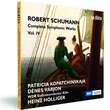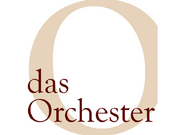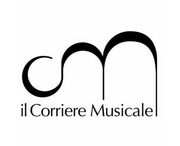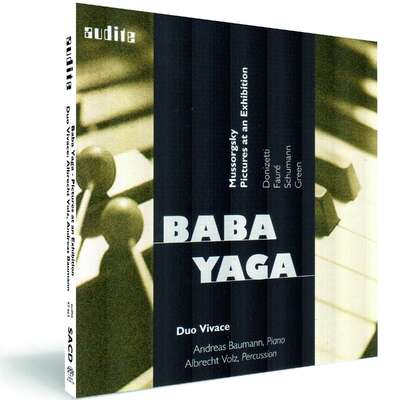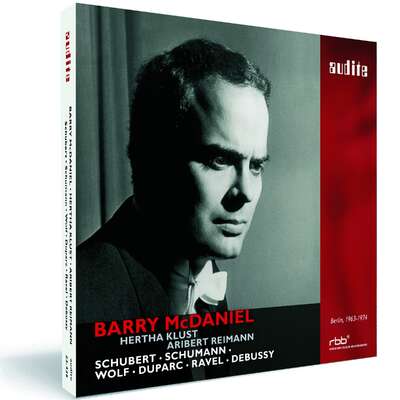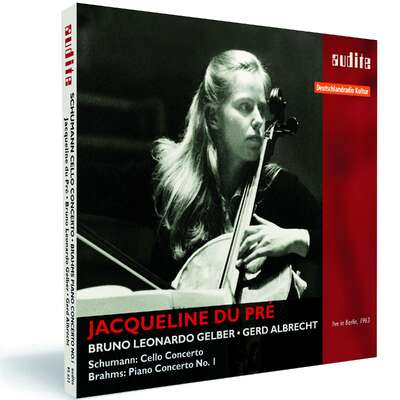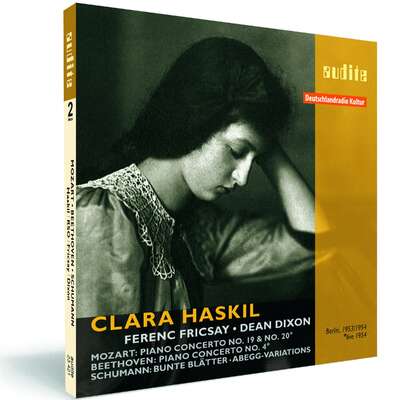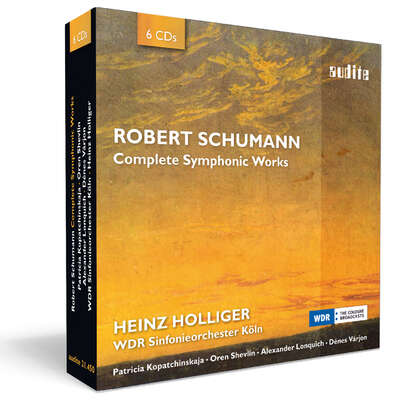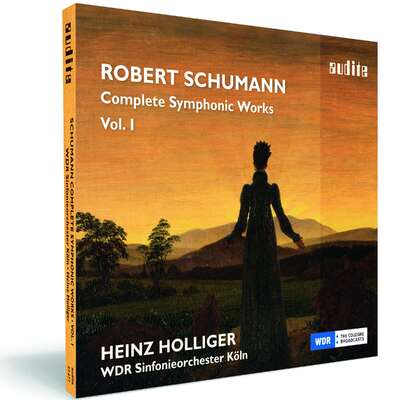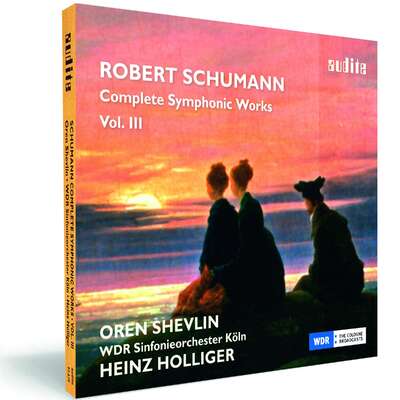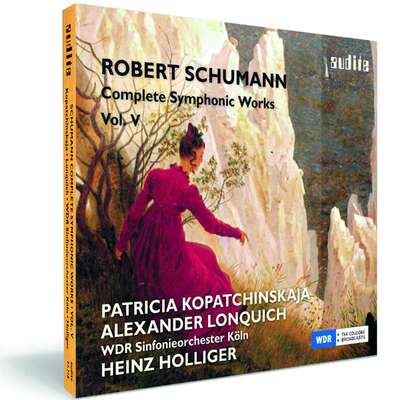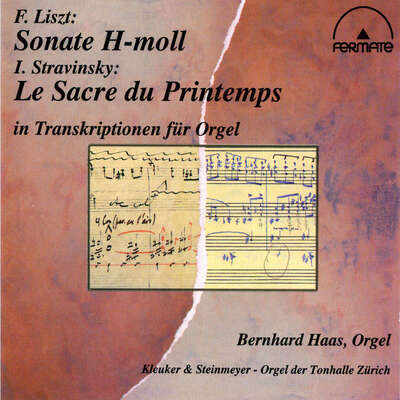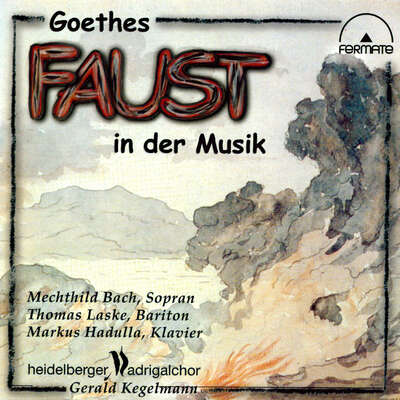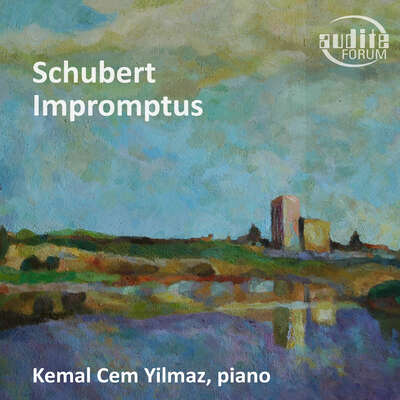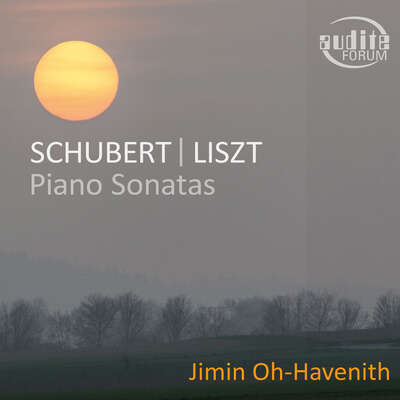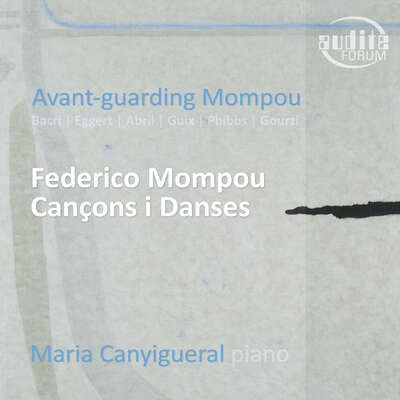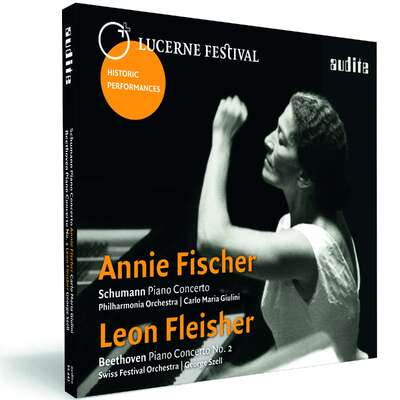
Schumann’s most underestimated and his most famous concertos: Patricia Kopatchinskaja takes the experimental qualities of the Violin Concerto, a late work, as a guiding principle for her individual interpretation, rising above clichéd Romanticist listening habits. In the Piano Concerto, Denes Varjon also expresses a particular Romantic clarity, characterised by fresh sounds and fluid tempi.more
"Patricia Kopatchinskaja plays the Violin Concerto with an elemental conviction I have not heard. Her attack is phenomenal and she obviously believes every note she is playing. In the melting slow movement she will break your heart" (The Herald Scotland)
Details
| Robert Schumann: Complete Symphonic Works, Vol. IV | |
| article number: | 97.717 |
|---|---|
| EAN barcode: | 4022143977175 |
| price group: | BCA |
| release date: | 26. February 2016 |
| total time: | 63 min. |
Bonus Material
Informationen
This fourth volume of the complete orchestral works by Robert Schumann presents both his most underestimated and his most famous concertos.
Patricia Kopatchinskaja takes the experimental qualities of the Violin Concerto, a late work, as a guiding principle for her individual interpretation, rising above clichéd Romanticist listening habits. A clear sound, thanks to reduced vibrato and open strings, as well as a surprisingly accentuated but also at times withdrawn style of playing, fully integrated into the orchestra, shapes her distinctive, energetic interpretation. The Baroque elements hinted at in the score are thus echoed in the performance. This "de-Romanticised" reading clearly distinguishes Schumann's Violin Concerto from the glittering Romantic concertos of the time, contrasting brilliant, attention-seeking virtuosity with musical mastery at the service of an overall concept.
In the Piano Concerto, Dénes Várjon also expresses a particular Romantic clarity, characterised by fresh sounds and fluid tempi. He trusts in the impact of the work standing on its own by opting for an approach that is not overly Romanticist. His stringent interpretation is informed by many years of performing Schumann, including his chamber works.
The next instalment in this series is set to follow in March: volume five of the Schumann edition, featuring Patricia Kopatchinskaja with the Violin Fantasy, alongside Alexander Lonquich with the Konzertstücke for piano, as well as the Konzertstück for Four Horns and Orchestra.
April will see the release of the edition's final volume, showcasing the "Zwickau" Symphony as well as the complete Overtures.
Reviews
Correspondenz Robert Schumann Gesellschaft | Nr. 39 / Januar 2017 | Michael Struck | January 1, 2017
[Patricia Kopatchinskaja] zwingt uns zum Zuhören. Kein Ton lässt sie kalt. Sie liebt die Extreme, lebt sie geigerisch aus – und wirkt dann mitunter wie eine "Nina Hagen des klassischen Violinspiels".Mehr lesen
Rheinische Post | 28. Dezember 2016 | Volker Hagedorn | December 28, 2016 | source: http://www.rp-on...
Die Geister, die Robert Schumann rief
Sein großartiges Violinkonzert wird derzeit von vielen Geigern entdeckt. Ein Vergleich fördert spannende Entdeckungen zutage
"Robert hat ein höchst interessantes Violinkonzert beendet, er spielte es mir ein wenig vor, doch wage ich mich darüber nicht auszusprechen, als bisMehr lesen
Ach, hätten ihm Geisterstimmen doch noch zugeflüstert, dass 150 Jahre später fast alle großen Geiger sein Stück spielen würden! Vorläufige Krönung: drei der derzeit profiliertesten Geigerinnen. Als erste legte Isabelle Faust vor einem Jahr ihre Aufnahme mit dem Freiburger Barockorchester vor, es folgte Patricia Kopatchinskaja mit dem WDR-Sinfonieorchester, und nun ist auch Carolin Widmanns Aufnahme mit dem Chamber Orchestra of Europe (COE) zu haben. Die Musikerinnen, alle zur Generation der frühen 1970er zählend, haben endgültig jene Stufe der Rezeption gezündet, auf der es nicht mehr um eine umstrittene Rarität geht.
Denn dieses Werk gehört zum Großartigsten, was Schumann für sinfonische Besetzung geschrieben hat. Ein neuer Ton ist da zu hören, im ersten d-Moll-Satz blockhaft Archaisches in expressive Rückblicke drängend, im zweiten Satz subtilste Rhythmik. Mit dem Finale indes hatte schon Clara ein Problem, und Joachim fand es "entsetzlich schwer für die Geige". War das ein Grund, die Partitur zu verstecken? Auf Claras Wunsch kam sie nicht in die Gesamtausgabe. Joachim, Besitzer des Autographs, verwies dazu 1889 auf "eine gewisse Ermattung, welcher geistige Energie noch etwas abzuringen sich bemüht".
Auf ihn und Clara geht die zählebige "ideé fixe" zurück, Schumanns Spätwerk zeige Züge geistiger Zerrüttung. Joachims Sohn verkaufte das Autograf der Preußischen Staatsbibliothek 1907 mit der Auflage, das Konzert 100 Jahre lang nicht zu publizieren, Schumanns Tochter Eugenie wehrte sich noch als Greisin gegen die Publikation, die 1937 nur möglich wurde, weil die Nazis einen "arischen" Ersatz für das Violinkonzert von Felix Mendelssohn brauchten. Dem Nationalgeiger Georg Kulenkampff war die Partie zu schwer (anders als zur selben Zeit dem jungen Yehudi Menuhin in den USA), und kein Geringerer als Paul Hindemith gab sich dazu her, von 523 Takten der Sologeige mehr als die Hälfte umzuschreiben, sie hochzuoktavieren, einfacher spielbar und dabei "brillanter" zu machen – was faule Routiniers gern "dankbar" nennen.
Auch diese "Uraufführung" vom 26. November 1937 kann man nun wieder hören, ohne die einleitenden Worte von Propagandaminister Goebbels zu Beginn dieser "Kraft durch Freude"-Veranstaltung in Berlin. Georg Kulenkampff hetzt durch den ersten Satz wie durch eine Zirkusnummer, den letzten Satz hat er von Schumanns Metronomzahl 63 auf 104 hochgedreht, und der langsame Satz versinkt zum Glück im spacigen Zirbeln der Interferenzen und Datenverluste, die sich beim Überspielen welker Wachsplatten auf Band ergaben. Obwohl auch Yehudi Menuhin das Werk wenig später in den USA spielte, hatte es nun einen braunen Schatten zusätzlich zum Zerrüttungsverdacht. Wirklich verlässliche Notenausgaben gibt erst seit knapp zehn Jahren.
Diese lange Geschichte ist wie weggeblasen, wenn das famose Chamber Orchestra of Europe dirigentenlos in den ersten Satz einsteigt, schneller als von Schumann gedacht, voller Sturm und Drang. Die leeren E-Saiten der Geigen werden bewusst expressiv, fast schmerzhaft eingesetzt, was die Nachdenklichkeit der Solistin um so deutlicher macht. Den halben Noten zwischen ihren Sechzehnteln sinnt Carolin Widmann wie mit weiten Blicken nach, während Kopatchinskaja diese Töne ankrallt, hinschmeißt, fast wütend, und Isabelle Faust lange und kurze Noten in Schönheit verbindet – nuancenreich, nicht oberflächlich.
Das Freiburger Barockorchester, von Pablo Heras-Casado geleitet, entwickelt dabei nicht so viel Sog wie das Chamber Orchestra of Europe, lässt aber Registerwechsel, Farbkontraste deutlicher werden und ist trockener aufgenommen. Das größer besetzte WDR-Sinfonieorchester unter Heinz Holliger, als Autor ein kompetenter und subtiler Schumann-Versteher, wirkt dagegen etwas gedeckelt und unterspannt – in kuriosem Kontrast zur Geigerin Patricia Kopatchinskaja, der ihr Eigensinn öfter wichtiger ist als das poetische Potenzial der Musik. Krachende Tonbildung im Forte und Pianissimi an der Grenze der Hörbarkeit können durchaus nerven, auch wenn man ihr alle Aktionen glaubt und sich oft fragt, was ihr wohl als nächstes einfällt. Sie gibt ein bisschen das "bad girl".
Die Überraschungen ihrer Kolleginnen liegen in dem, was sie bei Schumann entdecken. Während Isabelle Faust ihn behutsam mit der weiten Welt verbindet, geht Carolin Widmann ins Innere und beschert uns im langsamen Satz die zärtlichsten Töne, unfassbar intim. Ihre schlichten leisen Synkopen in Takt 13 und 14 wagt man kaum ein zweites Mal zu hören, so etwas Unwiederbringliches haben sie. Dabei hilft freilich eine Aussteuerung, die die Solovioline auch bei leisesten Tönen unterstützt, während Isabelle Faust realistischer aufgenommen wurde, tiefer im Geflecht der umgebenden Töne. Genau das hat man Schumann – im bornierten Vergleich mit Genrestandards – vorgeworfen: Sein Solopart bewege sich zu oft im Schatten tieferer Lagen.
Vielleicht nimmt sich da einfach ein Subjekt zurück? Im Finale gilt das allerdings auch fürs Genie. Vielleicht war es Zeitdruck, der Schumann hier auf die "Images der Polenromantik" (so der Musikwissenschaftler Reinhard Kapp) vertrauen ließ: Eine gigantische Polonaise tritt auf der Stelle, Holzbläser verbreiten schauerlichen sächsischen Humor und die Geige spinnt fingerbrecherische Girlanden. Soll man das einfach schnell hinter sich bringen? Widmann und Kopatchinskaja drehen das Tempo auf 80 hoch, nur Faust lässt sich (fast) auf Roberts Angabe ein, und prompt scheint die Violine doch etwas zu sagen. Nur was? Rätsel hinter einer lächelnden Maske: Wir sollten nicht glauben, ihn jetzt zu kennen.
Record Geijutsu | Dec.2016 | December 1, 2016 Spezielle Empfehlung
Japanische Rezension siehe PDF!Mehr lesen
Die Zeit | Nr. 43 vom 13. Oktober 2016 | Volker Hagedorn | October 13, 2016
Roberts Rächerinnen
Faust, Kopatchinskaja und Widman: Drei profilierte Geigerinnen haben Schumanns Violinkonzert eingespielt
Wie gewohnt gibt die Moldawierin ein bisschen das bad girl.Mehr lesen
Frankfurter Allgemeine Zeitung | Montag, 19. September 2016 Nr. 219 | Jan Brachmann | September 19, 2016
Redet diese Musik, träumt sie?
Zwei Editionen mit den Konzerten von Robert Schumann wetteifern um die Deutung – auf hohem Niveau
Holliger und Kopatchinskaja machen im Violinkonzert auch Schumanns Zerrissenheit hörbar. Anschwellend, ausbrechend, versinkend entfaltet sich das erste Orchestertutti. In Kopatchinskajas erst dünnem, dann schnell und scharf akzentuiertem Geigenton liegen Wachheit, Reizbarkeit, bis jäh die Spannkraft erlahmt, die Sehnsucht nach Rückzug spürbar wird – und die Musik implodiert. Gespenstisch doppelgesichtig fallen Selbstbehauptung und seelische Ermüdung auseinander. Im Souveränitätsverlust treten Seiten des Menschlichen zutage, aus denen Kunst eine eigene Dringlichkeit gewinnt. Holliger hat das erkannt – und zugelassen.Mehr lesen
Das Orchester | 09/2016 | Thomas Bopp | September 1, 2016 | source: http://www.dasor...
Zur Aufnahme mit Isabelle Faust und dem Freiburger Barockorchester haben nun auch Heinz Holliger und seine Solistin Patricia Kopatchinskaja im Rahmen der Gesamtveröffentlichung aller Orchesterwerke Schumanns mit dem WDR Sinfonieorchester Köln ihre Sicht auf das Violinkonzert niedergelegt. Und die dürfte Schumanns Vorstellungen vielleicht sogar noch um einiges näher kommen, als dies Isabelle Faust und den Freiburgern gelungen war.Mehr lesen
Spiegel online
| Sonntag, 21.08.2016 | Werner Theurich | August 21, 2016 | source: http://www.spieg...
Violinkonzerte: Schumanns spätes Sorgenkind
Für die Violine gibt es beliebtere Konzerte als das von Robert Schumann. Carolin Widmann nahm sich das als spröde verschriene Werk vor. Bei ihr klingt es ganz anders als bei der Kollegin Kopatchinskaja
Man sieht Patricia Kopatchinskaja förmlich die Polonaise des dritten Satzes tanzen, weiß man doch aus ihren Konzerten, dass sie gerne mal den angestammten Solistenplatz verlässt und über die Bühne wandelt.<br /> <br /> Ihrem ausdrucksstarken und triumphierenden Spiel tut das Wilde natürlich keinen Abbruch, außerdem kann sie sich auf das sichere Geflecht der WDR-Truppe verlassen. Kopatchinskajas druckvoller Ansatz bekommt dem nun gar nicht so spröden Konzert ebenso ausgezeichnet wie Widmanns ganz andere Akzente. Klar ist auf jeden Fall: Schumanns lange geschmähtes Sorgenkind ist aller Sorgen ledig, wenn es in den richtigen Händen liegt.Mehr lesen
Ihrem ausdrucksstarken und triumphierenden Spiel tut das Wilde natürlich keinen Abbruch, außerdem kann sie sich auf das sichere Geflecht der WDR-Truppe verlassen. Kopatchinskajas druckvoller Ansatz bekommt dem nun gar nicht so spröden Konzert ebenso ausgezeichnet wie Widmanns ganz andere Akzente. Klar ist auf jeden Fall: Schumanns lange geschmähtes Sorgenkind ist aller Sorgen ledig, wenn es in den richtigen Händen liegt.
Fanfare | August 2016 | Huntley Dent | August 1, 2016
The Schumann Violin Concerto, rejected in his lifetime by its dedicatee, Joseph Joachim, and suppressed after his death by his wife Clara and devotedMehr lesen
As a non-fan of the Violin Concerto, I can hardly credit that I am even more enthusiastic about this new release in Heinz Holliger’s ongoing Schumann orchestral cycle, of which this is Volume 4, with the extraordinary violinist Patricia Kopatchinskaja as soloist. In its daring departures from convention their reading surpasses Faust’s in fascination. To begin with, Kopatchinskaja, who was born in the former Soviet republic of Moldavia in 1977, has assumed the mantle of the late Lydia Mordkovitch for fierceness of attack and courageous nonconformity. Her timbre here is almost never consistent within a phrase or even beautiful. The tone whistles, whines, and scrapes as often as it sings, all in service of an interpretation that takes not a single note for granted. I associate this kind of keenly felt violin playing with Leila Josefowicz and more recently the young Norwegian phenom Vilde Frang. But Kopatchinskaja is the only violinist who has the ferocity to frighten me—I found her extreme interpretation of the Prokofiev Violin Concerto No. 2 and the Stravinsky Violin Concerto with Vladimir Jurowski from 2013 (Naïve) almost too unsettling to listen to. But it and her other releases, especially a disc of violin concertos by Eötvös, Bartók, and Ligeti on the same label, have been rapturously received, or at the very least caused heads to turn. The same is certainly true here.
The Schumann Piano Concerto exists at the opposite end of universal love and admiration, which makes things difficult for a relative unknown like Hungarian pianist Dénes Várjon—he won’t be unknown to those who have heard his recordings on Naxos, ECM, Hyperion, Capriccio, and other labels (I seem to be out of the loop on this one). A graduate of the Liszt Academy in Budapest, where he now teaches, Várjon has recorded Holliger’s music under the composer, so I assume a close musical affinity. Here they collaborate to produce a reading of the A-Minor Concerto that I’d describe as streamlined but intense. Tempos and phrasing are not out of the ordinary. The total timing is about the same as for Jan Lisiecki’s recent DG recording (reviewed in Fanfare 39:5), but where Lisiecki is poetic to the point of being subdued, Várjon puts his technique on extrovert display. Short of Martha Argerich’s charismatic, rocket-fueled interpretations, this is one of the more engaging readings of the solo part that I’ve heard, even if the finale loses oomph after a while.
Heinz Holliger has focused his Schumann cycle on making us hear the music without prejudice and absent the traditional Schumann Romantic sound. His starkness in the Violin Concerto succeeds remarkably well, although the orchestral part in the Piano Concerto feels a little abrupt and dry at times. At 77 he’s very much a force to be reckoned with. Holliger’s transition from superstar oboist to composer and conductor has worked on all counts, although here he doesn’t make the WDR Symphony sound better than workmanlike. That hardly matters, nor does the good but not exceptional recorded sound. It’s Kopatchinskaja’s highly original playing that wins the day.
Fanfare | August 2016 | Jim Svejda | August 1, 2016
The fourth and fifth volumes of Audite’s Schumann series with Heinz Holliger and the West German Radio Symphony are in many ways the mostMehr lesen
The version of the Piano Concerto is all we’ve come to expect from this excellent series, including alert, rhythmically flexible playing from a first-class radio orchestra (people who play to microphones for a living), a conductor who knows his business in Schumann (a firm grasp of the long line, an ability to clarify the occasionally dense inner voicing, a total lack of fear when it comes to punching the telling accent, an uncanny knack for pointing out the previously overlooked—but deeply important—detail), together with superbly realistic recorded sound that nonetheless bathes everything in an early-Romantic glow. The young Hungarian pianist Dénes Várjon takes a wonderfully fresh and unaffected approach to this familiar music; while everything feels perfectly controlled, he bends the bar line in a way that recalls the great Schumann pianists of the past (Cortot and Rubinstein especially) but nothing feels willful or self-aggrandizing. If the finale lacks the head-long excitement of Fleisher, Janis, Richter, and others, then overall it’s an immensely satisfying outing that makes you want to hear some of the solo piano music from this source. (There’s already an excellent version of the violin sonatas with Carolin Widmann on ECM 1902 and an even finer recording of the cello music with Steven Isserlis on Hyperion 67661.)
Wild child Patricia Kopatchinskaja’s presence guarantees an immensely individual look at the problematic Violin Concerto, and, as usual, she doesn’t disappoint. From her first entrance, it’s a startlingly original interpretation, with a seemingly endless variety of tone color—insured by her endless types of vibrato—down to that chilling moment in the heart of the first movement where the line is so drained of life it sounds like someone keening at a funeral. (There are other moments where the sound is so intense at the lower range of audibility that you wonder if she heard of Leonard Bernstein’s extraordinary instruction to a string section: “Play triple piano, but use the kind of vibrato you use playing triple forte.”) Holliger adds as much point and thrust as he possibly can to the outer movements—especially the opening movement, which for once never seems to drag—and although the slow movement seems less a premature anticlimax than usual, things never quite add up (as they never quite have, at least on records).
Kopatchinskaja is just as committed and persuasive in the violin Fantasie, whose gypsy-like opening flourishes are a reminder that it was written for the Hungarian-born Joseph Joachim, who actually played the piece (he refused to touch the concerto). Like the late Concert Allegro with Introduction which Schumann began writing only three days after the Fantasie was finished, it’s a work whose thematic inspiration is pretty thin gruel, as is the working out of the basic material. Like Kopatchinskaja, pianist Alexander Lonquich does everything he can to invest his part with life and interest, though well before the Concert Allegro begins you realize why—after a certain point—the composer’s widow stopped playing it in public.
All concerned are on far firmer footing in the earlier Introduction and Allegro appassionato, written well before Schumann was beginning to lose his grip on things. Lonquich responds admirably to the work’s impetuosity and high romance, though not with quite the same magical fusion of freshness and knowing finesse Jan Lisiecki achieves in his recent recording with Antonio Pappano (DG 479 5327).
The orchestra’s horn section turns in a spectacular account of the op. 86 Konzertstück, which still gets recorded far more frequently than it’s actually performed, given that its often stratospheric writing for the first horn is an endless series of clams just waiting to happen. Holliger and the soloists’ colleagues give them rousing support, though the closing bars lack the visceral excitement of Gerard Schwarz and the Seattle Symphony’s madcap dash to the end (Naxos 8.572770).
Collectors of this fine series will have snatched up both installments by now; others can proceed with minimal caution, as anything Kopatchinskaja does these days is mandatory listening.
www.peterhagmann.com
| 13. Juli 2016 | Peter Hagmann | July 13, 2016 | source: http://www.peter...
Ein Fall für die ideale Diskothek
Die Orchestermusik Robert Schumanns in Aufnahmen mit dem Dirigenten Heinz Holliger
Ins ebenfalls späte, lange Zeit verkannte Violinkonzert stiegt Patricia Kopatchinskaja mit geradezu erschreckender Verve ein, während Dénes Várjon im Klavierkonzert vorführt, was behende Leichtfüssigkeit diesem früher gern hingedonnerten Werk beibringt. Viel zu hören gibt es da, viel zu entdecken und zu staunen.Mehr lesen
BBC Music Magazine | July 2016 | Erik Levi | July 1, 2016
Patricia Kopatchinskaja is typically bold and provocative in Schumann's Violin Concerto. Largely eschewing the full-blooded sonorities favoured byMehr lesen
Heinz Holliger and the WDR Sinfonieorchester are responsive partners both in the Violin Concerto and its far less problematic counterpart for piano. This latter work is presented in a relatively straightforward manner by Dénes Várjon, who emphasises its playfulness and lightness of touch, especially in the slow movement and Finale.
Holliger is particularly good at bringing out light and shade in Schumann's orchestration and highlighting inner details. This clarity of texture is evident throughout the two Konzertstücke for piano Op. 92 and Op. 134, where Holliger matches Alexander Lonquich's muscular tone with powerfully driven orchestral tuttis. The Konzertstücke for four horns, magnificently executed by the orchestra's principals, also benefits from Holliger's insights, the irresistible exuberance of the outer movements contrasting with the mellifluous expressiveness achieved in the central Romanze. Less convincing is the Fantasie for violin and orchestra, composed in the same year as the Violin Concerto but less exalted. Kopatchinskaja shows considerable charismatic imagination in projecting the rustic features of the faster section, but makes a few slips of intonation.
The Strad | June 15, 2016 | Peter Quantrill | June 15, 2016 | source: http://www.thest... Two of today’s leading violinists take on the challenge of Schumann’s Concerto
The more consistently inspired outer movements bring out her quixotic, mercurial best, and once past an awkward edit into the finale, Kopatchinskaja makes this gawky but charming polonaise smile in ways that elude most of the competitionMehr lesen
Mostly Classic | 2016.6 | June 1, 2016
Japanische Rezension siehe PDF! Mehr lesen
MJ | 2016.6 | Ikuo Tsunoda | June 1, 2016
Japanische Rezension siehe PDF!Mehr lesen
Crescendo Magazine | Le 22 mai 2016 | Ayrton Desimpelaere | May 22, 2016 Fin d’une très belle intégrale Schumann par Heinz Holliger
La violoniste Patricia Kopatchinskaja offre quant à elle une lecture éclairée et déterminée. Sous la baguette attentive de Heinz Holliger, elle exploite toute l’étendue de ses capacités pour rendre sa lecture passionnante. Il suffira d’écouter le mouvement central pour saisir la douceur du timbre et la compréhension sans faille de l’architecture. Patricia Kopatchinskaja croit en chaque note et dégraisse magistralement cette œuvre trop souvent négligée.Mehr lesen
Infodad.com | May 12, 2016 | May 12, 2016 When soloists soar
Having long since proved himself a superior oboist, Heinz Holliger is nowMehr lesen
Gramophone | 03.05.2016 | David Threasher | May 3, 2016
Schumann’s Violin Concerto has one of the strangest histories of all great Romantic works. His last piece for orchestral forces, it was inspired byMehr lesen
This coincided with a particularly stressful period in Schumann’s personal and professional life, not least the fallout from his deficiencies as a conductor with the Düsseldorf Musikverein. He was plagued by illness; but work on music for Joachim—two sonatas, the Phantasie, Op 131, and the Concerto—invigorated him and he remarked often on his ability to concentrate diligently on the music for his young new fiddler friend.
Joachim never performed the concerto, though. With Schumann’s decline and suicide attempt, the violinist considered the work to be ‘morbid’ and the product of a failing mind; he wrote that it betrayed ‘a certain exhaustion, which attempts to wring out the last resources of spiritual energy’. This attitude evidently rubbed off on Clara and Brahms, who omitted it from the complete edition of Schumann’s works. Joachim retained the manuscript and bequeathed it to the Prussian State Library in Berlin upon his death in 1907, stating in his will that it should be neither played nor published until 1956, 100 years after Schumann’s death.
It was in 1933, however, that it came to light. This is where the story turns very peculiar. The violinist sisters Jelly d’Arányi and Adila Fachiri held a séance in which the shade of Schumann asked that they recover and perform a lost piece of his; then Joachim’s ghost handily popped up to mention that they might look in the Prussian State Library. A copy of the score was sent to Yehudi Menuhin, who pronounced it the ‘missing link’ in the violin literature between Beethoven and Brahms, and announced he would give its premiere in October 1937. D’Arányi claimed precedence on account of Schumann’s imprimatur (albeit from the other side), and the German State invoked their copyright on the work and demanded a German soloist have the honour. Georg Kulenkampff was eventually entrusted with the world premiere; Menuhin introduced it in the US and d’Arányi in the UK.
It’s long been considered a problematic work, owing partly to Joachim’s opinion of it, partly to some supposedly heavy scoring and partly to the awkward gait of the polonaise finale, which can too easily become a graveyard for dogged soloists. Nevertheless, it’s something of a rite of passage for recording violinists, and two of the finest present it on new discs, as Patricia Kopatchinskaja goes head-to-head with Thomas Zehetmair. Kopatchinskaja (with the Cologne WDR SO under Heinz Holliger in Vol 4 of his series of Schumann’s ‘Complete Symphonic Works’) displays the full range of sounds she is able to draw from her instrument, spinning something almost hallucinatory in the slow movement. The tone employed by Zehetmair (directing the Orchestre de Chambre de Paris) is more focused, more centred, as would appear to be his outlook on the work: all three movements are 40 seconds to a minute faster than Kopatchinskaja. Nevertheless, her concentration and imagination sustain the performance, and Holliger and his players follow her lead in creating some wondrous sounds, demonstrating yet again that Schumann’s orchestration isn’t as leaden as it’s often made out to be.
On first hearing, I wasn’t sure if I’d wish to revisit Kopatchinskaja’s disc in a hurry. But there’s something magnetic about her vision of the work, about the abandon with which she plays, never shunning an ugly tone when it’s called for. Zehetmair’s tidier, more dapper performance avoids such ugliness and makes choosing between the two an invidious choice. Holliger couples an energetic performance of the Piano Concerto with Dénes Várjon, incorporating in the first movement some features of the earlier Phantasie on which it was based, and which some might prefer to the self-conciously individual recent readings by Ingrid Fliter (reviewed on page 40) or Stephen Hough (Hyperion, 4/16). Zehetmair offers a lithe, spontaneous Spring Symphony and the fiddle Phantasie that Joachim did play.
Pat Kop also offers this latter work, on Vol 5 of Holliger’s series. Again, she takes a more spacious, more reactive approach than Zehetmair; elsewhere on the disc, Alexander Lonquich is similarly more inclined to let the music breathe in Schumann’s two single-movement concertante piano works than, say, the tauter Jan Lisiecki (DG, 1/16). The real draw here, though, is the Konzertstück for four horns and orchestra, in a performance that makes a truly joyful noise, even if it’s perhaps less sleek than Barenboim in Chicago or less steampunk than John Eliot Gardiner with a quartet of period piston horns.
These days, you’re as likely to find—on disc, at least—the Cello Concerto co-opted by violinists. Jean-Guihen Queyras returns it to the bass clef, though, completing the series of the three concertos and piano trios with Isabelle Faust, Alexander Melnikov and the Freiburg Baroque Orchestra under Pablo Heras-Casado. Queyras gives the best possible case for the concerto, making a virtue of the relative short-windedness of period instruments but exploiting their greater ensemble clarity. Where the gut strings really tell, though, is in the First Piano Trio—especially at those points at which Schumann asks for new sounds, such as in the first-movement development, where he tells the string players to play at the bridge for an eerie, glassy sound. I’ve enjoyed all the discs in this series without necessarily preferring them to certain older (modern-instrument) favourites. The combination of Queyras’s concerto and the wonderful, driven D minor Trio, though, leads me to suspect that this is the most persuasive of the three.
Thüringen Kulturspiegel | Mai 2016 | Dr. Eberhard Kneipel | May 1, 2016
AIte Schönheit - neuer Glanz
Die Gesamtaufnahme von Robert Schumanns Orchesterwerken beim Edel-Label audite
Erster Anlauf, erstaunliche Experimente, imponierende Meisterwerke: Ein außergewöhnliches und an Entdeckungen reiches Hör-Erlebnis ist zu haben – auch dank audite!Mehr lesen
MJ | MAY 2016 | Naoya Hirabayashi | May 1, 2016
Japanische Rezension siehe PDF!Mehr lesen
Die Bühne
| Nr. 5 Mai 2016 | May 1, 2016
Empfehlungen der BÜHNE-Redaktion: Sterne des Monats
CD des Monats: Schumann, Complete Symphonic Works Vol. IV (audite)
Derzeit erlebt Schumanns Violinkonzert eine wahre Renaissance. Nach Isabelle Faust und Pablo Heras-Casado (harmonia mundi) bricht nun eine weitere CDMehr lesen
F. F. dabei | Nr. 9/2016 vom 30. April bis 13. Mai | April 30, 2016 Mediamarkt – F.F. sichtet Musik- und Literaturangebote
Die fünfte Folge der Reihe ergänzt die Solokonzerte mit den kompakten Konzertstücken des Komponisten. Patricia Kopatchinskaja und Alexander Lonquich setzen dabei ihre ganz eigene Handschrift in die Kompositionen.Mehr lesen
http://theclassicalreviewer.blogspot.de | Wednesday, 13 April 2016 | Bruce Reader | April 13, 2016 A very fine Violin Concerto from Patricia Kopatchinskaja that will surely help this work to gain acceptance and a particularly musical performance of the Piano Concerto in A Minor from Dénes Várjon on Heinz Holliger’s fourth volume of his complete survey of the orchestral works of Schumann for Audite
This is a particularly musical performance lacking in any superficial show for virtuosity’s sake. They receive an excellent recording again from the Philharmonie, Koln and there are excellent booklet notes.Mehr lesen
Basler Zeitung | Montag, 4. April 2016 | Sigfried Schibli | April 4, 2016 Holligers Schumannfeier
Vor allem das späte Violinkonzert dürfte in der Aufnahme mit der Geigerin Patricia Kopatchinskaja mit dem WDR-Sinfonieorchester Köln unter Heinz Holliger für Diskussionsstoff sorgen. Die Solistin spielt die Sechzehntelketten des ersten Satzes mit unerhörter Zärtlichkeit; in der Durchführung kommt dann eine Zerbrechlichkeit hinzu, welche die Musik fast zum Stillstand bringt. Das ist mit grosser Behutsamkeit und in der Absicht gespielt, der Musik alles Kraftstrotzende, Gesunde auszutreiben.Mehr lesen
CD Journal | APR. 2016 | April 1, 2016
Japanische Rezension siehe PDF!Mehr lesen
concerti - Das Konzert- und Opernmagazin | April 2016 | Dr. Eckhard Weber | April 1, 2016 Unfassbar
Holliger durchmisst mit dem vor Energie strotzenden WDR Sinfonieorchester eine unfassbare räumliche Tiefe – Kopatchinskaja lässt ihren Geigenton vielfach schillern, das alles in präziser Linienführung. Schumanns Klavierkonzert dagegen befreien Holliger und Pianist Denes Varjon entspannt und reflektiert von schwülstiger Romantik, verleihen ihm Dynamik und Licht. Wahre Referenzaufnahmen!Mehr lesen
hifi & records | 2/2016 | Uwe Steiner | April 1, 2016
Patricia Kopatchinskajas Seelenton, im Lyrischen an der Grenze zum Verstummen, offenbart die kaum verhohlene, doch nie ausgestellte Melancholie dieser demonstrativ unvirtuosen Abschiedsmusik. Denes Varjon legt eine genau ausgehörte Deutung des Klavierkonzerts vor, die gerade auch im Finale nicht über die rhythmische Struktur hinwegmusiziert.Mehr lesen
Musica | N° 275 - aprile 2016 | Giuseppe Rossi | April 1, 2016
Un rinnovato interesse per le opere orchestrali di Robert Schumann ha vistoMehr lesen
Fono Forum | April 2016 | Michael Kube | April 1, 2016
Nach fast anderthalb Jahren setzt das Label audite seinen Schumann-Zyklus mit einer Doppelfolge fort. Aufgrund der Besetzung und der Werke fraglos einMehr lesen
Wie so oft erweist sich alles nur als eine Frage der Interpretation – von der Verständigkeit gegenüber dem Notentext über das aufmerksame Zusammenwirken bis hin zur passgenauen Artikulation und das rechte Tempo. In diesem Sinne gelingt es Holliger und seinen Solisten mit den Konzertstücken für Klavier op. 92 und op. 134 (Alexander Lonquich) sowie der Violin-Fantasie op. 131 tatsächlich zu überzeugen: Man hört einen Komponisten, dem das virtuose Element eigentümlich fremd und doch so nah war, dem am Ende aber der poetische Gedanke mehr zählte als jede leere Phrase. Hier begegnen sich über mehr als 150 Jahre hinweg die Komponisten Schumann und Holliger auf ästhetischer Ebene – der Dirigent Holliger aber weiß, wie auch der rechte Tonfall in einer klanglich agilen, in nahezu jedem Moment die Aufmerksamkeit bannenden Aufnahme festzuhalten ist. Umso mehr muss der stark aufgeraute, bisweilen kantige Zugriff von Patricia Kopatchinskaja im Violinkonzert verstören, der nicht gerade vor wohliger Wärme sprüht; das kühle Solo des langsamen Satzes lehrt einen gar das Frösteln. Daneben vermag Dénes Várjon im delikat angegangenen Klavierkonzert mit seinem eher vorsichtigen, keineswegs griffigen Forte nicht vollständig zu überzeugen.
Record Geijutsu | APR. 2016 | April 1, 2016
Japanische Rezension siehe PDF!Mehr lesen
Stuttgarter Zeitung | 22.03.2016 | Dr. Uwe Schweikert | March 22, 2016
Eine Großtat für Robert Schumann
Heinz Holliger und das WDR Sinfonieorchester Köln nehmen das gesamte sinfonische Werk auf
Man sagt wohl nicht zu viel, wenn man diese CDs als die wichtigste Schumann-Einspielung seit langem rühmt. Sie beweist, dass es keines historischen Instrumentariums und auch keines Spezialistenensembles bedarf, um die Werke aus dem Geist der Zeit für heute aufs Neue zu verlebendigen.Mehr lesen
ClicMag | N° 36 - 03/2016 | Pascal Edeline | March 1, 2016
Patricia Kopatchinskaja takes the experimental qualities of the Violin Concerto, a late work, as a guiding principle for her individual interpretation, rising above clichéd Romanticist listening habits. In the Piano Concerto, Dénes Várjon also expresses a particular Romantic clarity, characterised by fresh sounds and fluid tempi.Mehr lesen
www.opusklassiek.nl | maart 2016 | Gerard Scheltens | March 1, 2016 | source: https://www.opus...
het vioolconcert met de wervelende " Pat Kop" een waar feest.Mehr lesen
Audio | 03/2016 | Lothar Brandt | March 1, 2016
Bei seinem Violinkonzert, das Robert Schumann noch vor dem Fall in die geistige Umnachtung vollenden konnte, fühlen sich Geiger und KommentatorenMehr lesen
BBC Radio 3 | Record Review - Saturday 27th February 2016 | Andrew McGregor | February 27, 2016
BROADCAST
Record Review
Sendebeleg siehe PDF!Mehr lesen
The Herald Scotland | Friday 26 February 2016 | Michael Tumelty | February 26, 2016
Moldovan-born violinist Patricia Kopatchinskaja plays the Violin Concerto with an elemental conviction I have not heard. Her attack is phenomenal and she obviously believes every note she is playing. In the melting slow movement she will break your heart;Mehr lesen
http://asiagolfonline.com | 26.02.2016 | February 26, 2016
Patricia Kopatchinskaja plays the Violin Concerto with an elemental conviction I have not heard. Her attack is phenomenal and she obviously believes every note she is playing. In the melting slow movement she will break your heartMehr lesen
www.ilcorrieremusicale.it | 13 febbraio 2016 | Stefano Cascioli | February 23, 2016
Prosegue l’integrale delle opere sinfoniche di Schumann che l’AuditeMehr lesen
Rondo | Nr. 936 // 16. - 22.04.2016 | Guido Fischer | February 19, 2016
Herb, mit ungeschöntem Zugriff, bis an die Grenze des Brutalen richtet Patricia Kopatchinskaja den Blick auf die klaffenden Wunden, die diese Partitur eben auch offenbart. Und der Finalsatz ist trotz des Sehnsuchtstons doch ein einziger Seelentaumel.Mehr lesen
Vorarlberger Nachrichten | 19. Februar 2016 | Fritz Jurmann | February 19, 2016 MusikTipps von Fritz Jurmann
[...] auch hier setzt [Kopatchinskaja] in [Schumanns] späten, oft verkannten Violinkonzert d-Moll mit vibratoarmem Spiel und leeren Saiten deutliche Akzente. Experimentelle Züge dienen der Künstlerin als Leitbild für ihre stark individuelle Lesart jenseits aller klischeehaft romantisierten Hörgewohnheiten. Desgleichen verfährt sie mit seiner Fantasie für Violine, die ihrer ungezügelten Spielweise besonders entgegenkommt.Mehr lesen
www.pizzicato.lu | 11/02/2016 | Alain Steffen | February 11, 2016 Holligers moderner Schumann
Ich habe mit Heinz Holliger als Dirigent nicht selten meine Schwierigkeiten. Gerade im romantischen Repertoire ist er mir oft zu kühl und zuMehr lesen
Wie schon Isabelle Faust räumt auch Kopatchinskaya mit den Klischees auf und zeigt uns Schumanns Musik in einem sehr frischen und dynamischen Gewand. Holliger dirigiert erstaunlich musikantisch, verzichtet aber wie gewohnt auf zu starke romantische Exkurse. So stehen vor allem ein aktzentreiches und klares Musizieren im Vordergrund.
Mit dem gleichen Konzept geht Holliger auch das beliebte Klavierkonzert an. Genussvoll lässt er das hervorragend disponierte WDR Sinfonieorchester Köln aufspielen, sieht aber seinen Schumann auch hier durch eine strengere klassischere Brille. Was der Musik aber sehr gut tut. Dénes Varjon spielt das Konzert sehr virtuos und mit einer sehr deutlichen Artikulation. Ob man jetzt dieses eher unromantische Interpretationskonzept mag oder lieber die Werke in der klassischen Optik sieht sei einem jeden überlassen. Für mich jedenfalls kommt das Violinkonzert in der Interpretation Kopatchinskaya/Holliger sehr nahe an das Referenzniveau heran.
Vol V. präsentiert etwas weniger attraktive Werke. Hier sticht insbesondere das Konzertstück für vier Hörner ins Auge. Holliger und seine Solisten wollen von Jägerromantik nichts wissen und spielen das Stück äußerst präzise und klar. Der Wohlklang der Hörner ist zwar präsent, ist aber mehr das Resultat einer analytischen und architektonisch begründeten Interpretation als das einer rein atmosphärisch orientierten. Alexander Lonquich spielt die beiden Konzertstücke für Klavier und Orchester op. 92 & 114 mit schönem Ton und ausgewogenem Ausdruck, Kopatchinskaya ist in der Fantasie für Violine und Orchester wieder einmal überragend. Heinz Holliger kann diesen drei Werken deutlich weniger interessante Aspekte abgewinnen als dem Violinkonzert oder dem Klavierkonzert.
Heinz Holliger continues to explore Schumann’s symphonic works in a very clear and analytical way. The highlight of the CDs is the very fresh and vivid performance of the Violin Concerto.
